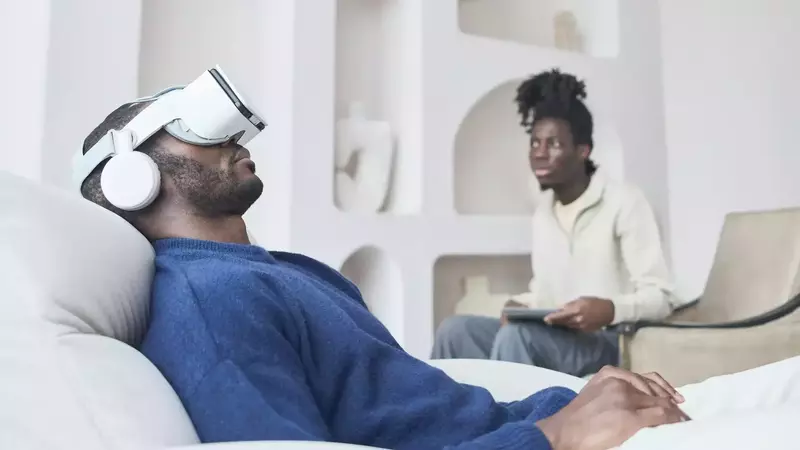This site contains affiliate links to products, and we may receive a commission for purchases made through these links.
How is virtual reality used in healthcare? This intriguing question has sparked the curiosity of gamers, explorers, and those eager to learn about the cutting-edge applications of VR technology.
In this blog post, we will delve into the various ways virtual environments are revolutionizing the healthcare sector.
We’ll discuss the numerous benefits that VR simulations offer to both patients and healthcare professionals alike. From medical education to physical rehabilitation, you’ll discover how these immersive experiences are transforming patient care and outcomes within the industry.
Moreover, we will explore real-life examples of VR being employed in diverse medical applications such as stroke rehabilitation and mental health treatments. Despite its immense potential, there remain challenges that must be addressed for widespread adoption across the healthcare landscape.
Finally, we will ponder on what lies ahead for virtual reality in shaping our future health practices.
Dive into this fascinating world with us as we examine how is virtual reality used in healthcare today!

1. What is Virtual Reality?
Immersing users into a computer-generated world, VR technology enables them to engage with the virtual environment in real-time.
By wearing specialized VR headsets, users can experience realistic simulations of various scenarios and environments, ranging from gaming experiences to professional training applications.
VR has recently become more widely adopted across many industries, particularly healthcare. Healthcare professionals are increasingly leveraging this cutting-edge technology for medical education, patient treatment, and overall improvement of patient outcomes.
A Brief Overview of How VR Works
- Sensory Input: Users wear a headset equipped with sensors that track their movements and adjust the virtual environment accordingly. This creates a seamless connection between the user’s actions and their perception within the simulation.
- Visual Display: High-resolution screens inside the headset project images directly onto each eye lens separately creating depth perception and simulating three-dimensional space similar to how we perceive our real-life surroundings.
- Auditory Feedback: Headphones or built-in speakers provide spatial audio cues which help immerse users further into their virtual experiences by delivering sounds corresponding to events happening within it.
- Haptic Feedback: Some VR systems also incorporate haptic feedback devices such as gloves or vests that enable tactile sensations during interactions with objects or characters in simulated environments providing more realism while engaging in these activities.
The combination of sensory input, visual display, auditory feedback, and haptic response allows users to feel fully immersed in their chosen virtual environments – be it for entertainment, education, or professional purposes.
As VR technology continues to advance and become more accessible, its applications within the healthcare industry are rapidly expanding.
Immersive tech providing synthetic surroundings for a range of applications, virtual reality (VR) is being utilized to unlock new possibilities. By examining the implications of VR in healthcare, we can comprehend how this revolutionary technology could drastically improve patient care and treatment outcomes.
2. Benefits of VR in Healthcare
The use of virtual reality in the healthcare sector has grown significantly over recent years, offering numerous benefits to both patients and healthcare professionals.
From improved patient outcomes to cost savings and increased efficiency, VR technology is revolutionizing the way medical services are provided.
A. Enhanced Medical Education and Training
Medical education and training have greatly benefited from virtual environments that simulate real-life scenarios for students and professionals alike.
These immersive experiences allow learners to practice procedures without risking harm to actual patients, thereby increasing their confidence before entering a real-world clinical setting.
B. Improved Physical Rehabilitation Outcomes
Patient recovery can be accelerated through the use of VR simulations during physical therapy sessions.
For example, stroke rehabilitation often involves repetitive exercises that may become monotonous for patients suffering from this condition.
However, incorporating virtual reality into these routines makes them more engaging while still promoting motor function improvement.
C. Effective Mental Health Treatments
Mental health treatments using VR headsets offer new possibilities for managing conditions such as anxiety disorders or post-traumatic stress disorder (PTSD).
By exposing individuals to controlled virtual environments designed specifically around their needs, therapists can gradually help them confront their fears or triggers safely – a process known as exposure therapy – which ultimately aids in reducing symptoms over time.
- Innovative Pain Management: Patients experiencing chronic pain may find relief through immersive VR applications that distract their minds from the discomfort. This non-invasive approach has shown promising results in reducing pain levels for various conditions.
- Reduced Hospitalization Costs: The healthcare industry can save on costs by utilizing virtual reality to deliver certain treatments remotely, such as mental health therapy or physical rehabilitation sessions. This allows patients to receive care without needing to travel or stay at a medical facility, thus lowering expenses and increasing accessibility.
- Better Patient Engagement: VR technology encourages active participation from patients during their treatment process, leading to better adherence and overall improved outcomes. By making therapies more enjoyable and engaging, individuals are more likely to commit fully to their recovery journey.
Incorporating virtual reality into healthcare practices not only enhances patient experiences but also empowers professionals with innovative tools that improve efficiency and effectiveness across the board.
VR in healthcare has the capacity to yield various advantages, from upgraded patient treatment to reduced expenses. Having discussed the potential benefits of VR in healthcare, let us now examine some current applications.
VR is transforming the healthcare industry, with potential advantages for both sufferers and clinicians. VR technology can enhance medical education and training, improve physical rehabilitation outcomes, provide effective mental health treatments, innovative pain management solutions while reducing hospitalization costs and increasing patient engagement.
3. Examples of VR in Healthcare
Virtual reality has already made a significant impact on the healthcare industry, with numerous applications ranging from medical training to mental health treatments.
In this section, we will explore some notable examples of how virtual reality is being used in healthcare today.
Medical Training and Education
VR simulations have become an invaluable tool for medical education, allowing students and professionals alike to practice procedures and develop skills without risk to real patients.
By immersing users in realistic virtual environments, these simulations can replicate various patient’s conditions and scenarios that may be encountered in the real world.
This not only helps improve overall competency but also allows trainees to gain confidence before working with actual patients.
Physical Therapy and Rehabilitation
Innovative uses of vr technology, such as specialized VR headsets or motion-tracking devices, are revolutionizing physical therapy by making it more engaging for patients suffering from a range of conditions like stroke rehabilitation or spinal cord injuries.
These virtual environments enable therapists to create customized treatment plans tailored specifically for each individual’s needs while providing instant feedback on their progress.
One example is the use of VR-based gaming systems during physical rehabilitation sessions, which can help motivate patients by turning exercises into fun challenges.
Mental Health Treatments

- Anxiety Disorders: Virtual reality exposure therapy (VRET) has been shown to be an effective treatment for various anxiety disorders, including phobias and post-traumatic stress disorder (PTSD). By gradually exposing patients to their fears in a controlled virtual environment, VRET can help them develop coping strategies and reduce symptoms over time. Research has demonstrated the effectiveness of this approach compared to traditional exposure therapy.
- Depression: VR technology is also being used to treat depression by providing immersive experiences that promote relaxation, mindfulness, or cognitive behavioral therapy techniques. For example, studies have shown that using VR-based meditation programs can lead to significant improvements in mood and well-being among individuals with depressive symptoms.
- Addiction: Virtual reality simulations are being utilized as part of addiction recovery programs by recreating triggering situations without the risk of relapse. This allows patients to practice refusal skills and build resilience against cravings within a safe environment before facing real-life challenges.
The examples above demonstrate just some of the many ways in which virtual reality is transforming healthcare sector practices today while offering exciting possibilities for future advancements.
VR in healthcare is a rapidly growing field with many potential applications, from training medical students to providing immersive therapy for PTSD. Despite the potential benefits of VR in healthcare, there are still some issues that need to be addressed before it can become a widely accepted part of medical practice.
VR is having a noteworthy influence on the healthcare sector, from training medical personnel to managing psychological health concerns. Notable examples include VR simulations for medical education, innovative uses of VR technology in physical therapy and rehabilitation, and virtual reality exposure therapy for anxiety disorders. These advancements offer exciting possibilities for future healthcare practices.
4. Challenges with VR in Healthcare
Despite its potential to revolutionize healthcare, virtual reality faces certain challenges such as privacy concerns, technical issues and accessibility.
Some of these obstacles include privacy concerns, technical issues, and accessibility.
Privacy Concerns
The use of VR technology raises privacy concerns, particularly when it comes to handling sensitive patient data.
As healthcare professionals utilize virtual environments for medical training or treatment purposes, there’s a risk that unauthorized individuals may gain access to confidential information.
To protect patient data, developers must ensure compliance with regulations such as HIPAA and implement robust security measures.
Technical Issues
Incorporating VR simulations into the healthcare industry also presents several technical challenges. For instance:
- Hardware limitations: High-quality VR headsets can be expensive and may require powerful computers to run smoothly.
- User discomfort: Prolonged use of VR devices might cause some users to experience motion sickness or eye strain.
- Lack of standardization: The absence of universal standards across different platforms could lead to compatibility issues between various software applications and hardware devices.
Making Virtual Reality Accessible for All Patients
A major challenge faced by the adoption of virtual reality in healthcare is ensuring equal access for all patients suffering from various conditions.
This includes making sure that physical rehabilitation programs using VR are tailored according to each patient’s condition while being mindful of potential barriers such as cost or availability.
Moreover, it is crucial to address the digital divide that exists between different socio-economic groups and geographic locations.
To ensure the widespread adoption of VR in healthcare, efforts must be made to make this technology affordable and accessible for all patients, regardless of their background or location.
Real-World Implementation
Last but not least, translating the success of virtual reality applications from controlled environments into real-world clinical settings can be challenging.
Healthcare professionals need adequate training on how to effectively use VR technology while ensuring patient safety.
To ensure the efficacy of VR-based interventions is adequately demonstrated, further research studies should be conducted to compare them with traditional methods.
This will help establish credibility among healthcare providers and encourage wider adoption within the industry.
The challenges of using VR in healthcare are numerous, but with the right resources and strategies these can be overcome. Gazing into the future, we will investigate how virtual reality is revolutionizing medical treatments and care provision.
VR has the potential to transform healthcare, yet there are difficulties that must be addressed such as privacy worries and technical issues like hardware constraints and a lack of uniformity. Additionally, making VR accessible for all patients is crucial, and real-world implementation requires adequate training for healthcare professionals and more research studies to validate its effectiveness.
5. The Future of VR in Healthcare
The future of virtual reality in the healthcare sector holds immense potential, with numerous applications that could revolutionize various aspects of medical practice and patient care.
As technology continues to advance, we can expect to see even more innovative uses for VR within the healthcare industry.
A. Remote Diagnosis and Treatment
Remote diagnosis and treatment using virtual environments are expected to become increasingly common as VR technology advances.
This will enable healthcare professionals to assess a patient’s condition from afar, reducing the need for patients suffering from chronic illnesses or living in remote areas to travel long distances for medical consultations.
B. Augmented Surgery
Incorporating augmented reality (AR), a related technology that overlays digital information onto real-world environments, into surgical procedures has the potential to improve accuracy and efficiency during operations significantly.
Surgeons could use AR headsets or glasses while performing surgeries, allowing them access relevant data such as 3D models of organs or live vital signs without having to look away from their work area.
C. Enhanced Medical Education & Training
- Virtual Reality Simulations: By offering immersive training experiences through virtual simulations, medical students can gain hands-on experience before working on real-life patients – this is particularly useful when learning complex procedures like surgery.
- Haptic Feedback Technology: Combining haptic feedback devices with VR headsets allows trainees not only to see but also feel the sensation of performing a procedure, further enhancing their learning experience.
D. Personalized Physical Rehabilitation
As VR applications continue to develop, we can expect more personalized physical therapy and rehabilitation programs for patients recovering from injuries or surgeries.
Virtual surroundings can be modified to meet the unique requirements and advancement of each individual, enabling healthcare providers to observe progress in a timely manner.
E. Mental Health Treatment Innovations
Virtual reality has already shown promise in treating various mental health conditions such as anxiety disorders and PTSD.
However, future advancements could lead to even more effective treatment methods.
For example, virtual embodiment therapies, where patients “step into” an avatar representing themselves within a virtual environment, have the potential to revolutionize how therapists approach treatments like exposure therapy or cognitive-behavioral interventions.
The possibilities are vast when considering the future of VR technology within the healthcare sector – from improving medical education and training processes to providing innovative solutions for patient care across various disciplines such as physical rehabilitation and mental health treatments.
Potential applications of virtual reality (VR) in healthcare have the capacity to revolutionize medical practice and patient care. The future of VR includes remote diagnosis and treatment, augmented surgery, enhanced medical education and training through virtual simulations, personalized physical rehabilitation programs for patients recovering from injuries or surgeries, and mental health treatment innovations such as virtual embodiment therapies. As technology progresses, we can anticipate further inventive usages of VR within the medical field.
Frequently Asked Questions How is Virtual Reality Used in Healthcare
How is virtual reality used in healthcare?
Virtual reality (VR) is used in healthcare for various purposes, such as medical training and education, pain management, rehabilitation, therapy for mental health disorders, and surgical planning. It provides an immersive environment that enables medical professionals to practice procedures and patients to undergo treatments without risks or side effects.
How is virtual reality expanding healthcare?
VR expands healthcare by offering innovative solutions like remote consultations through telemedicine platforms. It also enhances patient engagement during treatment processes by providing realistic simulations of real-life situations. Moreover, VR can help reduce anxiety and stress levels among patients undergoing complex procedures or therapies.
What is the future of VR in healthcare?
The future of VR in healthcare includes more widespread adoption across various fields such as diagnostics, personalized medicine, and home-based care. Additionally, advancements in technology will lead to improved realism within virtual environments which could further enhance its effectiveness as a therapeutic tool.
How does VR help medical students?
VR helps medical students by providing them with realistic simulation experiences where they can practice their skills before working on actual patients. This allows them to gain confidence while reducing the risk of errors during real-world clinical scenarios. Some examples include practicing surgeries using virtual 3D models, learning anatomy through interactive modules or participating in simulated emergency situations.
Final Thoughts
In conclusion, virtual reality (VR) is a technology that has been widely adopted in the healthcare sector.
It offers numerous benefits such as improving patient outcomes, enhancing medical training and education, and providing patients with immersive experiences for physical rehabilitation and mental health treatment.
Examples of VR applications include stroke rehabilitation, pain management therapy, surgical simulations, and exposure therapy for phobias.
Yet, there are still obstacles to be conquered, including the pricey equipment and restricted availability. Despite the challenges, VR technology is becoming increasingly more accessible and cost-effective in healthcare, offering great potential for future applications.
If you want to learn more about how virtual reality is used in healthcare or other industries like marketing or e-commerce visit Pursuit Meta. Pursuit Meta provides cutting-edge solutions using advanced technologies like AI/ML & AR/VR.

Espen
Espen is the Director of PursuitMeta and has written extensively about Virtual Reality and VR Headsets for years. He is a consumer product expert and has personally tested VR Headsets for the last decade.






Leave a Reply